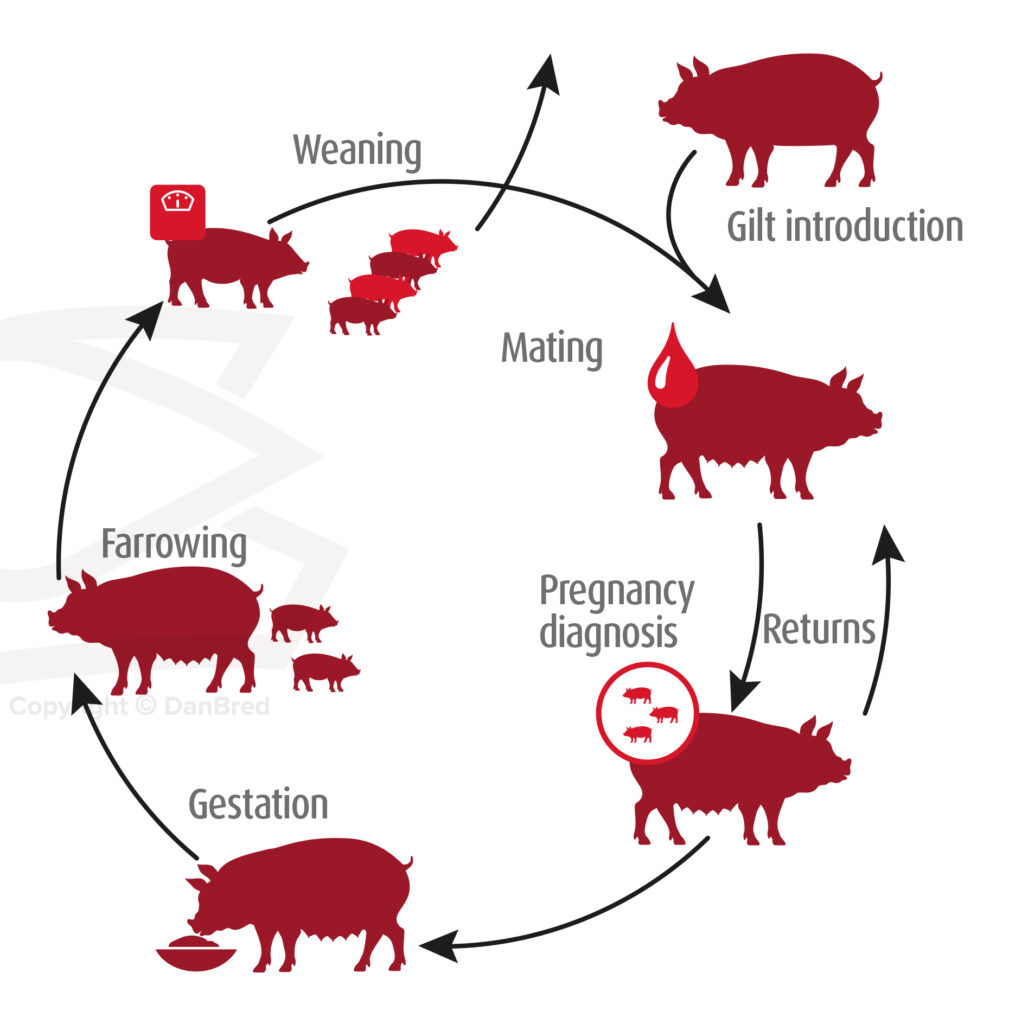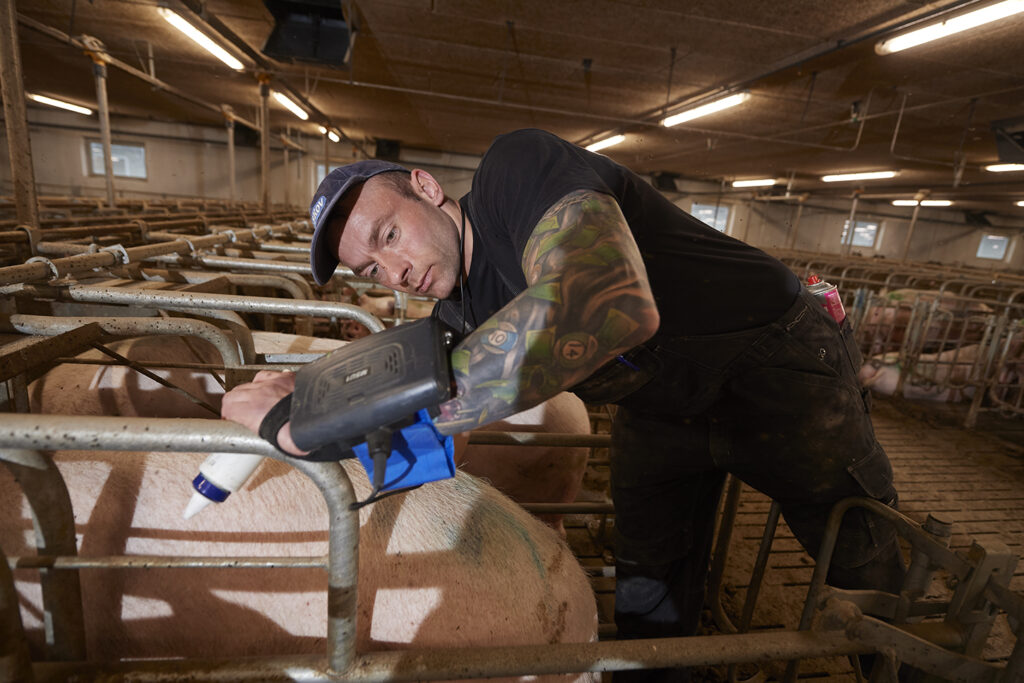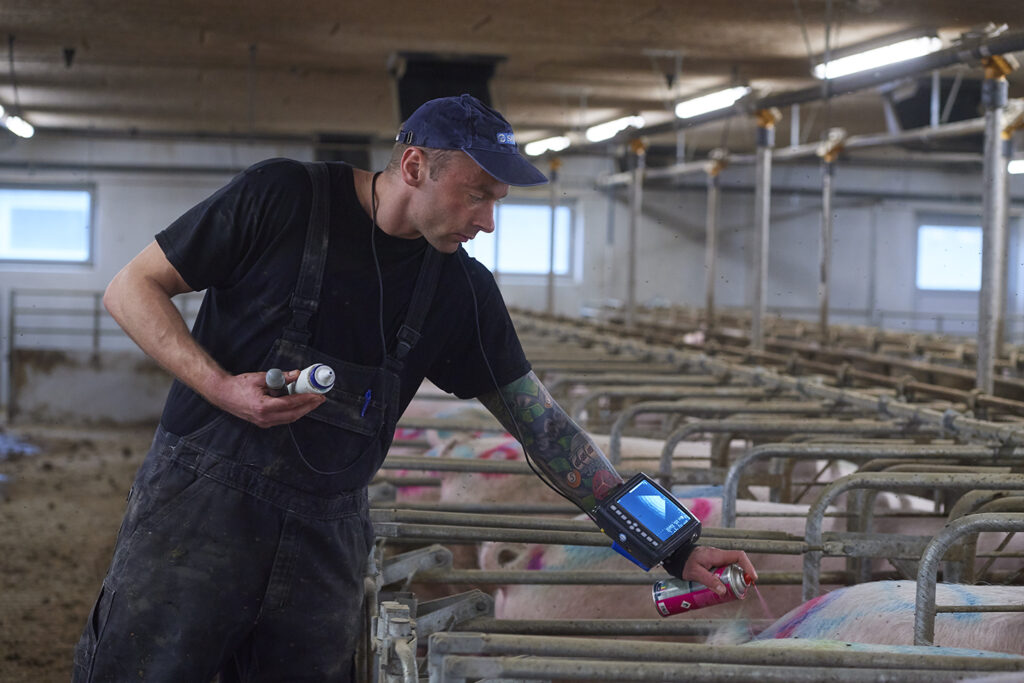Pregnancy testing – Worth the effort
Content
Why pregnancy testing is worth the effort
Attain the full potential of DanBred with systematic management of on-farm pregnancy tests combined with a consequent culling strategy to optimise overall efficiency and reduce Non-Productive Days.
Increase productivity by systematic on-farm pregnancy testing
DanBred breeding animals deliver extraordinary reproduction results and attentive systematic performance of on-farm pregnancy tests combined with a consequent culling strategy will optimise the overall production efficiency and reduce Non-Productive Days (NPD). A high number of pregnant or lactating sows and gilts increases reproductive efficiency, whilst maximising both productivity and the use of space. Increasing the number of possible productive days by eliminating NPDs will enlarge the number of litters per year as well as increase the number of number of pigs weaned.
Efficient pregnancy diagnostics increase productivity
 On farm pregnancy diagnostics must be efficient, secure, inexpensive and easy to perform. The time spent on pregnancy testing as well as the training of staff to do so is money well spent. It is important that all members of staff know the culling strategy set for sows returning to service, as well managed protocols and successful implantation of culling strategies will ultimately minimise NPDs.
On farm pregnancy diagnostics must be efficient, secure, inexpensive and easy to perform. The time spent on pregnancy testing as well as the training of staff to do so is money well spent. It is important that all members of staff know the culling strategy set for sows returning to service, as well managed protocols and successful implantation of culling strategies will ultimately minimise NPDs.
Many diagnostic methods have been tested over the years. Using a boar for detection of heat is one of the most common methods and has shown to be very efficient as it is almost 100 % certain that a sow which shows signs of being in heat after mating failed to conceive when mated (DPRC, 2017). Non pregnant sows will normally return to oestrus within 17 to 24 days after mating, therefore daily nose-to-nose contact between sows and a boar from day 19 to day 28 is recommended (Almond, 1994).
Ultrasound scanning the sows between day 28 to 42 has shown significant accuracy in finding non-pregnant sows, but is dependent on both the equipment used as well as the technicians’ skills- training is therefore essential (DPRC, 2017). When finding returning sows it is imperative that these are moved to the mating unit straight away- optimised feeding and daily boar exposure can provoke a new heat, and thereby return the sow into production – alternatively the sow must be culled (DPRC, 2017).
| Week of Gestation | Days of Gestation |
Method |
Percentage of non-pregnant sows/gilts |
| 3+ | 17-24 | Boars and heat check | 80% |
| 5+ | 24-35 | Ultrasound | 15% |
| 8-10 | 56-70 | Visual | 5% |
Table 1: Methods for pregnancy diagnosis according to time of gestation
Easy steps to maximise production with accurate pregnancy diagnostics


 Heat detection
Heat detection
- Use a boar in front of the sows every day from day 19 to day 28 after mating
- During a quiet time of the day check for the 8 signs of heat;
- Swelling and redness of the vulva
- Clear fluid discharge from vulva
- Lack of appetite
- Increased activity/restlessness
- Perked or twitching ears
- Tail flicking up and down
- Vocalization or grunting
- Standing reflex.
- Use an older, odorous and high libido boar
- For loose house systems, keep the boar in a pen with an opening into the sows and use the electronic registration to track which sows show interest in the boar.
Ultrasound scanning
- The ultimate goal of pregnancy detection is to identify non-pregnant females before 35 days of gestation
- Scan all sows once between day 24 and day 28 after mating
- If in doubt of the diagnosis mark the sow and scan again within a week
- For optimised results, a second scan of all sows can be done around day 42
- Timing ultrasound scanning with a feeding can help efficiency
- Following the scanning evaluate the body condition in order to optimise feeding during gestation.
Strategy for returns
- Clearly mark sows in heat or scanned non-pregnant
- Move sows in heat or scanned non-pregnant to the mating unit or cull depending upon protocol
- Check for heat every day
- Inseminate when standing heat is detected
- Let the sow continue in the new week batch
- Set a culling strategy for returning sows and make sure that all employees know the strategy (for example cull after 2nd unsuccessful mating)
References
Almond G.W. (1994): Pregnancy diagnosis – a Brief review, Proceedings of the North Carolina Healthy Hogs Seminar, College of Veterinary Medicine, North Carolina State University
Danish Pig Research Centre (DPRC) (2017) Drægtighedskontrol. SEGES Videncenter for Svineproduktion. Retrieved 03/02/19 https://svineproduktion.dk/viden/i-stalden/management/soeer/draegtighedskontrol
Danish Pig Research Centre (DPRC); H8B – Brunst- og drægtighedskontrol (2018). Online, Manual om repromanagement. SEGES Videncenter for Svineproduktion. Retrieved 03/02/19 https://svineproduktion.dk/Viden/I-stalden/Management/Manualer/Repro




